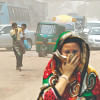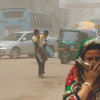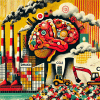Dhaka air pollution: Tejgaon industrial area tops the list

The air quality of 10 significant areas in the capital scored below standard throughout 2021, according to a study of the Centre for Atmospheric Pollution Studies of the Department of Environmental Science at Stamford University.
Tejgaon industrial zone topped the list of the 10 polluted zones with 70 microgrammes (mgs) of particulate matter (PM 2.5) per cubic metre whereas the acceptable level of PM 2.5 is 15mgs per cubic metre.
The study was conducted in the areas that have financial hubs, industrial zones, diplomatic and parliament.
According to the study, Shahbagh scored second on the list with 68mgs PM 2.5 per cubic metre.
Mirpur had 66mgs of PM 2.5, Gulshan 65mgs, Dhanmondi 63mgs, Abdullahpur 62mgs, Agargaon 61mgs, Motijheel 60mgs, Parliament area 59mgs and Ahsan Manjil 57mgs, read the study.
The average PM 2.5 concentration in the 10 areas is 63mgs per cubic metre, 4.2 times higher than the national standard set in Environment Conservation Act-1995.
The concentration is also 6.3 times higher than that set by the World Health Organization (WHO).
Megaprojects like metro rail, bus rapid transit and mass rapid transit, unfit vehicles and construction materials deteriorate the air quality of the city, the study found.
Apart from the heavy presence of PM 2.5, another particulate matter -- PM 10 -- was also found in Shahbagh, Mirpur-10 and Abdullahpur areas, the study said.
PM 10 was found at 101mgs per cubic metre in Mirpur, 100mgs in Shahbagh and 99 in Abdullapur. The presence of the particulate is twice the national annual standard.
The concentration of PM 2.5 and PM 10 varies from season to season in different areas.
In pre-monsoon, the highest concentration of PM 2.5 was 108mgs per cubic metre in Shahbagh whereas the upscale Dhanmondi-32 area saw the lowest concentration 57mgs per cubic metre.
In monsoon, though the air quality of the Parliament area improves to 33mgs per cubic metre, it is still three times higher than the international standard.
During the same season, Mirpur-10 saw the highest polluted air as its PM 2.5 reaches 49mgs per cubic metre.
On the other hand, in post-monsoon, the concentration of PM 2.5 is the highest in Tejgaon Industrial Area -- 113mgs per cubic meter -- while Gulshan-2 sees a bit improvement in its air quality -- 58mgs per cubic metre.
In winter, Dhanmondi-32 sees the highest concentration of PM 2.5 -- 155mgs per cubic metre and the lowest was found in Ahsan Manjil -- 74mgs per cubic metre.
Prof Dr Ahmad Kamruzzaman Majumder, who led the study, told The Daily Star that the scenario was really grim for Dhaka dwellers.
"We have to go for an inclusive way if we want a scientific and sustainable solution to air pollution," he said.
Contacted, Sharif Jamil, general secretary of Bangladesh Poribesh Andolon (BAPA), demanded a clean air act to contain the air menace urging the government to change its mindset towards air pollution.
Mohammad Asadul Haque, director (Dhaka metropolitan) of the Department of Environment, declined to make any comments saying they would have to take permission from the director general to talk to the media.
DoE Director General Md Ashraf Uddin, however, could not be contacted over the phone after repeated attempts.

 For all latest news, follow The Daily Star's Google News channel.
For all latest news, follow The Daily Star's Google News channel. 








Comments